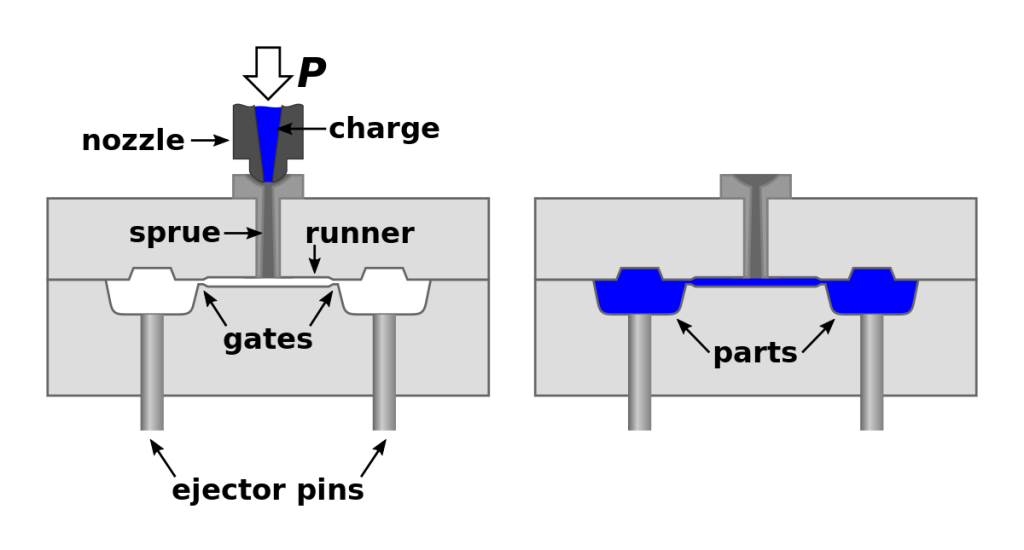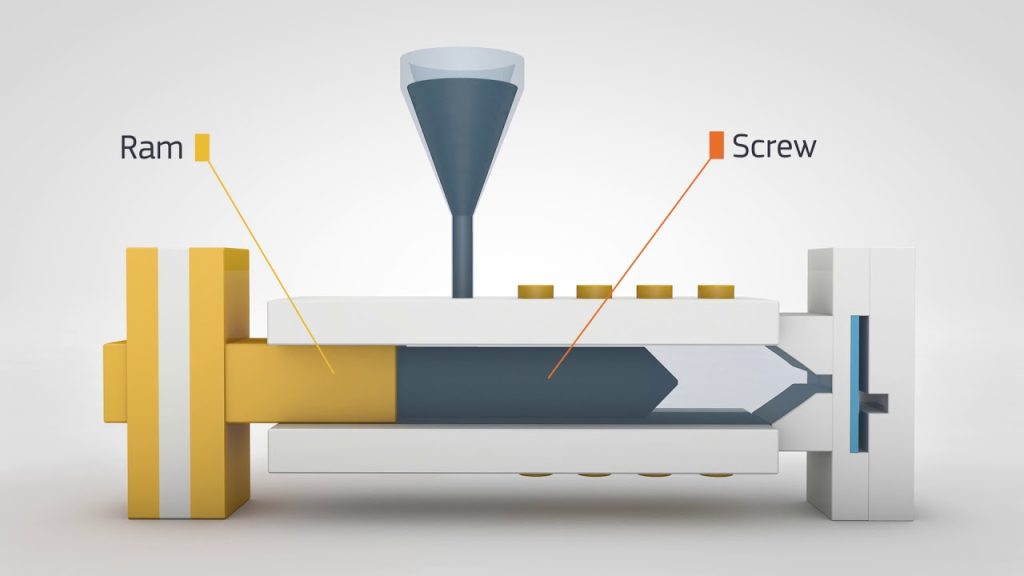Table of Contents
Injection molding is a popular manufacturing process that involves creating three-dimensional parts by heating plastic pellets and injecting them into a mold. However, one of the most frequently asked questions by manufacturers is, “How long do injection mold parts last?”
The answer to this question varies depending on several factors such as the type of material, the complexity of the mold, and the frequency of use. In this article, we will explore these factors in-depth and provide you with some tips on how to extend the lifespan of your injection mold parts. So, let’s dive in!
How Long Do Injection Mold Parts Last?
Injection molding is a manufacturing process that involves injecting molten plastic or rubber into a mold to create a product. Injection molds are designed to produce high-quality parts that are uniform in shape and size. However, the lifespan of injection mold parts is a common concern for many manufacturers. In this article, we will explore how long injection mold parts last and what factors can affect their lifespan.
Factors That Affect Injection Mold Parts Lifespan
There are several factors that can affect the lifespan of injection mold parts. These include:
1. Material Used: The type of material used to create the injection mold parts can have a significant impact on their lifespan. Some materials are more durable than others and can withstand wear and tear better.
2. Design: The design of the injection mold parts can also play a role in their lifespan. Parts that are designed with complex geometries or thin walls may be more prone to cracking or breaking.
3. Maintenance: Proper maintenance is essential to extending the lifespan of injection mold parts. Regular cleaning, lubrication, and inspection can help identify potential issues before they become serious.
4. Operating Conditions: The operating conditions of the injection molding machine can also affect the lifespan of the mold parts. High temperatures, pressures, and speeds can cause parts to wear out more quickly.
How Long Do Injection Mold Parts Last?
The lifespan of injection mold parts can vary depending on the factors listed above. However, in general, injection mold parts can last anywhere from several thousand cycles to hundreds of thousands of cycles. Some high-quality molds can even last up to a million cycles or more.
To put this into perspective, a cycle is defined as one complete injection molding process, from filling the mold with molten plastic to ejecting the finished product. The number of cycles that a mold can withstand before needing to be replaced depends on several factors, including the design of the mold, the material used, and how well the mold is maintained.
Benefits of Using High-Quality Injection Mold Parts
Using high-quality injection mold parts can offer several benefits to manufacturers, including:
1. Cost Savings: High-quality injection mold parts can last longer, reducing the need for frequent replacements and repairs. This can help save money in the long run.
2. Improved Product Quality: High-quality injection mold parts are designed to produce consistent, high-quality products, reducing the risk of defects or inconsistencies.
3. Increased Productivity: Since high-quality injection mold parts last longer and require less maintenance, they can help increase productivity by reducing downtime.
Injection Mold Parts vs. 3D Printed Parts
While injection mold parts offer several benefits, there are times when 3D printed parts may be a better option. Here are a few key differences between the two:
1. Cost: 3D printing can be less expensive than injection molding, especially for small production runs or prototypes.
2. Design Flexibility: 3D printing allows for greater design flexibility, making it easier to create complex geometries or unique shapes.
3. Production Time: 3D printing can be faster than injection molding for small production runs or prototypes.
However, when it comes to mass production, injection molding is usually the preferred method due to its efficiency and cost-effectiveness.
Conclusion
In summary, the lifespan of injection mold parts can vary depending on several factors, including material, design, maintenance, and operating conditions. High-quality injection mold parts can offer several benefits, including cost savings, improved product quality, and increased productivity. While 3D printing may be a better option for small production runs or prototypes, injection molding is usually the preferred method for mass production. Proper maintenance and care can help extend the lifespan of injection mold parts, ultimately saving manufacturers time and money.
Frequently Asked Questions
Injection molding is a widely used manufacturing process in which molten material is injected into a mold to produce a part. One of the most common questions asked about injection molding is how long the parts produced by the process last. Here are the answers to five frequently asked questions about the lifespan of injection mold parts.
How long do injection mold parts last?
The lifespan of injection mold parts depends on various factors, including the quality of the mold, the material used, and the conditions in which the parts are used. Generally, injection mold parts can last anywhere from several thousand to several million cycles. However, it is important to note that the mold’s life span can be affected by several factors, including the type of material being used and the complexity of the mold’s design.
There are also several steps that can be taken to extend the life of injection mold parts. These include regular maintenance and cleaning, proper storage, and the use of high-quality materials. By following these steps, it is possible to significantly increase the lifespan of injection mold parts and reduce the need for frequent replacements.
What factors affect the lifespan of injection mold parts?
As mentioned earlier, several factors affect the lifespan of injection mold parts. One of the most critical factors is the quality of the mold itself. High-quality molds are designed to withstand the rigors of the injection molding process and produce parts that meet the required specifications. In contrast, low-quality molds may wear out quickly and produce parts that are defective or out of tolerance.
The material used to produce the parts is another essential factor that affects their lifespan. Some materials, such as plastics, are more prone to wear and tear than others, and this can affect the life of the mold. Additionally, the conditions in which the parts are used can also affect their lifespan. Parts used in harsh environments, such as those exposed to high temperatures or corrosive substances, may wear out more quickly than those used in milder conditions.
What are some signs that an injection mold needs to be replaced?
Several signs indicate that an injection mold needs to be replaced. One of the most common signs is a decrease in the quality of the parts produced. For example, if the parts are out of tolerance or have defects, it may be a sign that the mold is worn out or damaged. Another sign that the mold needs to be replaced is if it requires frequent repairs or maintenance. If the cost of repairing the mold exceeds the cost of a new one, it may be time to consider replacing it.
Finally, if the mold has been in use for many years and has produced millions of parts, it may be at the end of its lifespan. In this case, it is often more cost-effective to replace the mold rather than continue using it and risking producing defective parts.
What are some tips for maintaining injection molds?
Maintaining injection molds is essential to extend their lifespan and produce high-quality parts. One of the most important things to do is to clean the mold regularly. This removes any dirt or debris that may accumulate in the mold and affect the quality of the parts produced. Additionally, it is crucial to inspect the mold regularly for signs of wear or damage.
Other tips for maintaining injection molds include using high-quality materials, properly storing the mold when not in use, and following the manufacturer’s recommended maintenance schedule. By following these tips, it is possible to extend the life of the mold, produce high-quality parts, and reduce the need for frequent replacements.
What are some benefits of using injection molding to produce parts?
Injection molding is a widely used process for producing parts, and it offers several benefits over other manufacturing processes. One of the most significant benefits is the ability to produce large quantities of parts quickly and efficiently. Additionally, injection molding allows for high levels of precision and accuracy, which is essential for producing parts that meet specific requirements.
Another benefit of injection molding is the ability to use a wide range of materials, including plastics, metals, and even ceramics. This flexibility makes it an ideal choice for producing parts for a variety of industries, including automotive, aerospace, and medical devices.
In conclusion, the lifespan of injection molded parts varies depending on several factors. However, with proper care and maintenance, injection molds can last for many years, producing high-quality parts that meet the required specifications.
One of the critical factors that determine the lifespan of injection molded parts is the type of material used. Some materials are more durable than others, and they can withstand more wear and tear, resulting in longer-lasting parts. Additionally, the design of the mold and the injection molding process used can also affect the lifespan of the parts.
Regular maintenance of the injection mold is also crucial in extending the lifespan of the parts. Proper cleaning, lubrication, and replacement of worn-out parts can prevent premature failure of the mold and ensure that the parts produced are of high quality. Ultimately, the lifespan of injection molded parts can be extended by adhering to best practices in mold design, material selection, and maintenance.
Request a quote today!
[contact-form-7 id="1578" title="Contact form"]
Please compress the file into a ZIP or RAR file before uploading. Alternatively, send through your RFQ by email.
enquires@unitymanufacture.com





